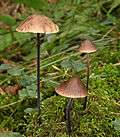Mycetinis
Mycetinis is a genus of fungus in the Omphalotaceae family, containing about eight species formerly classified in Marasmius.[2]
| Mycetinis | |
|---|---|
 | |
| Mycetinis scorodonius | |
| Scientific classification | |
| Kingdom: | Fungi |
| Division: | Basidiomycota |
| Class: | Agaricomycetes |
| Order: | Agaricales |
| Family: | Omphalotaceae |
| Genus: | Mycetinis Earle (1909)[1] |
| Type species | |
| Mycetinis alliaceus (Jacq.) Earle (1909) | |
| Species | |
|
M. alliaceus | |
General
This group of mushrooms was long known as a section (Alliacei) within the more familiar genus Marasmius, which means that each of the species has a synonym under Marasmius. They are distinguished from other Marasmius by the hymeniform cap skin which consists of smooth cells, with hyphae which do not show a dextrinoid reaction. The species have a characteristic garlic smell.[3]
DNA studies showed that the group is phylogenetically allied more to genus Gymnopus than to Marasmius, but the distinct structure of the cap skin is thought to justify a separation at the genus level. Franklin Sumner Earle had already defined the genus name Mycetinis for this group in 1909, though it had not caught on, and in 2005 Wilson & Desjardin proposed to resurrect this name and redefine it for the current taxonomy. The new phylogenetic classification also means that the group belongs to family Omphalotaceae instead of Marasmiaceae.[3][4]
A new species, M. curraniae, was described in 2012.
Species
| Image | Name | Notes | Distribution |
|---|---|---|---|
 | Mycetinis alliaceus | Type species | Europe |
| Mycetinis applanatipes | N. America | ||
_A.W._Wilson_and_Desjardin_65835.jpg) | Mycetinis copelandii | N. America | |
| Mycetinis curraniae | New Zealand | ||
_A._Ronikier_%26_Ronikier_674826.jpg) | (Mycetinis epidryas) | Synonym of Rhizomarasmius epidryas | Arctic (Europe, Canada & Alaska) or alpine |
| Mycetinis kallioneus | Arctic (Greenland & Svarlbard) | ||
_A.W._Wilson_and_Desjardin_528559.jpg) | Mycetinis opacus | N. America | |
| Mycetinis querceus | Europe, N. Africa | ||
| Mycetinis salalis | |||
 | Mycetinis scorodonius | Mainly Europe, also N. Africa, N. America, Israel | |
References
- Earle FS. (1906). "The genera of North American gill fungi". Bulletin of the New York Botanical Garden. 5: 373–451 (see p. 414).
- Kirk PM, Cannon PF, Minter DW, Stalpers JA (2008). Dictionary of the Fungi (10th ed.). Wallingford, UK: CAB International. p. 446. ISBN 978-0-85199-826-8.
- Antonín, V.; Noordeloos, M. E. (2010). A monograph of marasmioid and collybioid fungi in Europe. Postfach 1119, 83471 Berchtesgaden, Germany: IHW Verlag. pp. 395–396. ISBN 978-3-930167-72-2.CS1 maint: location (link)
- Wilson AW, Desjardin DE (2005). "Phylogenetic relationships in the gymnopoid and marasmioid fungi (Basidiomycetes, euagarics clade)". Mycologia. 97: 667–679. doi:10.1080/15572536.2006.11832797. PMID 16392255.